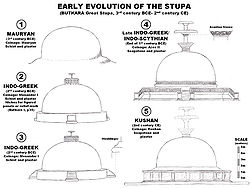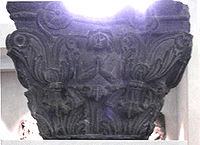
Butkara Stupa
Encyclopedia

Stupa
A stupa is a mound-like structure containing Buddhist relics, typically the remains of Buddha, used by Buddhists as a place of worship....
in the area of Swat
Swat (Pakistan)
Swat is a valley and an administrative district in the Khyber Pakhtunkhwa Province, located close to the Afghan-Pakistan border. It is the upper valley of the Swat River, which rises in the Hindu Kush range. The capital of Swat is Saidu Sharif, but the main town in the Swat valley is Mingora...
, Pakistan
Pakistan
Pakistan , officially the Islamic Republic of Pakistan is a sovereign state in South Asia. It has a coastline along the Arabian Sea and the Gulf of Oman in the south and is bordered by Afghanistan and Iran in the west, India in the east and China in the far northeast. In the north, Tajikistan...
. It may have been originally built by the Mauryan emperor Ashoka
Ashoka
Ashok Maurya or Ashoka , popularly known as Ashoka the Great, was an Indian emperor of the Maurya Dynasty who ruled almost all of the Indian subcontinent from ca. 269 BC to 232 BC. One of India's greatest emperors, Ashoka reigned over most of present-day India after a number of military conquests...
, but it is generally dated slightly later to the 2nd century BCE.
The stupa was enlarged on five occasions during the following centuries, every time by building over, and encapsulating, the previous structure.
Excavation

Greco-Buddhist art
Greco-Buddhist art is the artistic manifestation of Greco-Buddhism, a cultural syncretism between the Classical Greek culture and Buddhism, which developed over a period of close to 1000 years in Central Asia, between the conquests of Alexander the Great in the 4th century BCE, and the Islamic...
.
An Indo-Corinthian capital
Indo-Corinthian capital
Indo-Corinthian capitals are capitals crowning columns or pilasters, which can be found in the northwestern Indian subcontinent, and usually combine Hellenistic and Indian elements...
representing a Buddhist devotee within foliage has been found which had a reliquary and a coins of Azes II
Azes II
Azes II , may have been the last Indo-Scythian king in northern Indian subcontinent . After the death of Azes II, the rule of the Indo-Scythians in northwestern India and Pakistan finally crumbled with the conquest of the Kushans, one of the five tribes of the Yuezhi who had lived in Bactria for...
buried at its base, securely dating the sculpture to earlier than 20 BCE.
The nearby Hellenistic fortifications of Barikot
Barikot
Barikot is a town in the Khyber-Pakhtunkhwa province of Pakistan, located in the Swat valley region . Barikot is the present day name of the ancient "Bazira", which was besieged by Alexander the Great....
are also thought to be contemporary.
A large quantity of the artifacts are preserved in the National Museum of Oriental Art
National Museum of Oriental Art
The National Museum of Oriental Art is an important museum in Rome, Italy, dedicated to the arts of the Orient, from the Middle East to Japan....
and the City Museum of Ancient Art in Turin
Turin
Turin is a city and major business and cultural centre in northern Italy, capital of the Piedmont region, located mainly on the left bank of the Po River and surrounded by the Alpine arch. The population of the city proper is 909,193 while the population of the urban area is estimated by Eurostat...
's Turin City Museum of Ancient Art
Turin City Museum of Ancient Art
The Turin City Museum of Ancient Art is a museum located in the Palazzo Madama palace, in Turin, northern Italy.The museum has a rare collection of artifacts from Gandhara, coming from the Italian excavations of the IsMEO at the Butkara Stupa in Pakistan....
.

